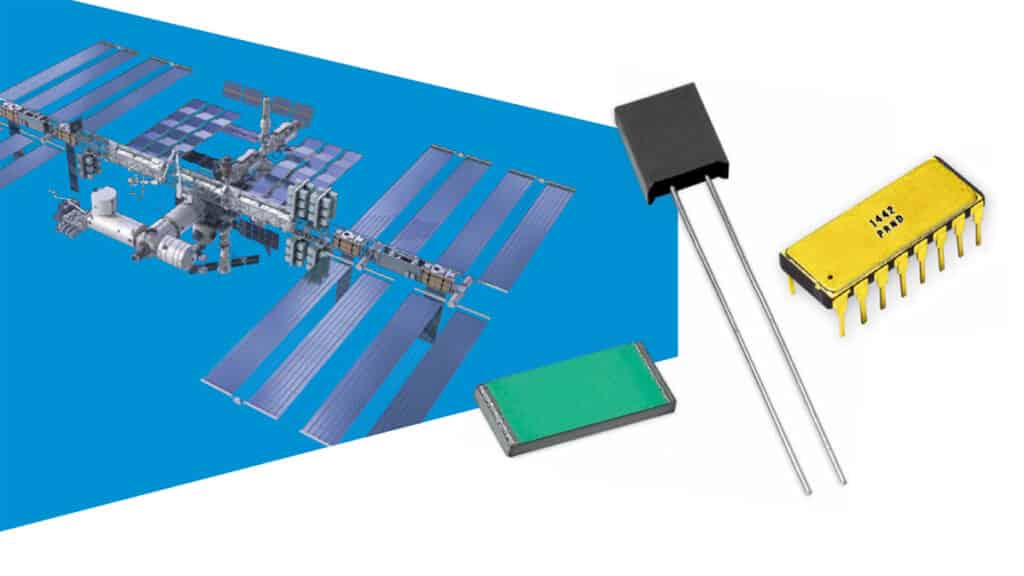When selecting a component in the signal path of a satellite system, it is often difficult to find a device with the radiation tolerance and the accuracy required.
Signal integrity is after all the key specification when designing an analog signal chain. The main causes of error to the integrity of the signal chain can be divided into two categories: inaccuracies due to noise and inaccuracies due to shifts in voltage. While it is important to consider all components in the signal path, one component is the most critical in achieving precision performance: the voltage reference.
Noise
Noise in a system can be reduced with the correct use of filters and the averaging of measurements when converting a signal from the analog domain to the digital domain. However, large or complex filters require board space and increased component count, not to mention added weight, resulting in higher costs. Large filters also increase the settling time for transient response. Averaging saves on extra component cost at the expense of sample frequency. The digital-to-analog converter requires a voltage reference with lower noise than the signal being measured to take advantage of averaging. For example, a 20-bit system requires the voltage reference to have a noise of less than 1 part per million (ppm). If the system requires higher precision than a voltage reference can deliver, averaging can still be used, but will be extremely costly as multiple analog-to-digital converters are needed. Each converter has its own voltage reference and the measurement from each is then averaged.
When a voltage reference is exposed to radiation, the noise increases. Although the increase in noise is not large, the above solution keeps the increase even lower. Also, popcorn noise sources would only exist sparsely with perhaps one site on a die, and they would not receive the gain of 11. If ever popcorn noise is found, it will be an order of magnitude smaller than in a traditional bandgap reference.
Voltage Shifts
Voltage shifts in a system may be reduced with fairly simple additional circuitry, although making adjustments across a full temperature range presents added difficulty. The cost of the additional circuitry is also high. Furthermore, offset voltages can only be corrected if they are detected, meaning that there must be a fixed voltage accurate enough to use as a base for the rest of the system. Once again the critical component of the system is the voltage reference. It sets the common mode for amplifiers, can be used to trigger comparators, and may be used to provide a stable supply to sensitive sensors. Most importantly, it sets the accuracy for the analog to digital and digital to analog converters.
Key aspects to consider on a voltage reference include initial accuracy, drift over temperature, drift over time and shift over radiation. Many voltage references provide trim options to adjust initial accuracy; however, the process requires external circuitry and may adversely affect the other specifications. A much simpler approach is to calibrate out the error on the digital side. Note that digital calibration reduces the total input signal voltage range by the amount of the error. Bandgap references can be found with an initial accuracy within hundredths of a percent before radiation.
Drift over temperature in precision voltage references is caused by imperfections in the elements making up the device and is not linear. The uncompensated curve of a bandgap reference is about 20ppm. One solution to improve the temperature coefficient of the device is to use trans linear circuitry to compensate for the curve by adding an exponential term to the current summation. With curve compensation, one is able to achieve a temperature coefficient lower than 3ppm.
Drift over time is independent of other shifts and occurs predominantly toward the beginning of the life of the reference. Thus, initial calibration does not help correct for this drift. Calibration after an initial burn in period is an option at the expense of the burn in time. Also, the cascade design for creating a bandgap reference does not just help reduce noise, it has been found to reduce the long-term drift as well.
Finally, shifts due to radiation are critical in space applications. Many voltage references provide excellent accuracy in industrial environments but have large shifts when exposed to radiation.
Precision resistors are one of the key components in voltage references.
Below is an example of customer requirements for a very stable precision resistor for such application:
Electrical Specifications:
- R1 = 20KΩ, R2 = 10KΩ, R3 = 20KΩ, R4 = 10KΩ
- Absolute Tolerance: 0.01% each
- Ratio Matching Tolerance: 0.01% R1 to R2; 0.01% R3 to R4
- Absolute TCR: ±2.0 ppm/°C (-55°C to +125°C, +25°C Ref)
- TCR Track: R1 to R2 & R3 to R4: 0.8 PPM/°C
- Rated Power: 0.2 W at 70 °C, for the entire resistive element R1 and R2, divided proportionally between the two values.
Four fundamental factors determine how “ideal” a precision voltage divider will be:
- Initial absolute resistance value, or how closely the absolute resistance value can be achieved
- How precisely the value of individual resistors can be controlled
- How precisely the end-of-life tolerance is maintained under a wide range of operating conditions and stress factors (temperature, humidity, load, ESD, etc.)
- Fast response without ringing and fast thermal stabilization, and the ability of the resistor to react to rapid switching without adversely affecting the circuit function
Networks from VPG Foil Resistors are the only devices to have perfected these four factors to eliminate the inter-parameter compromises inherent in all other types of technologies. All important characteristics-tolerance, long-term stability, temperature coefficient, power coefficient, ESD, noise, capacitance, and inductance-are optimized, approaching the theoretical ideal in total performance.
